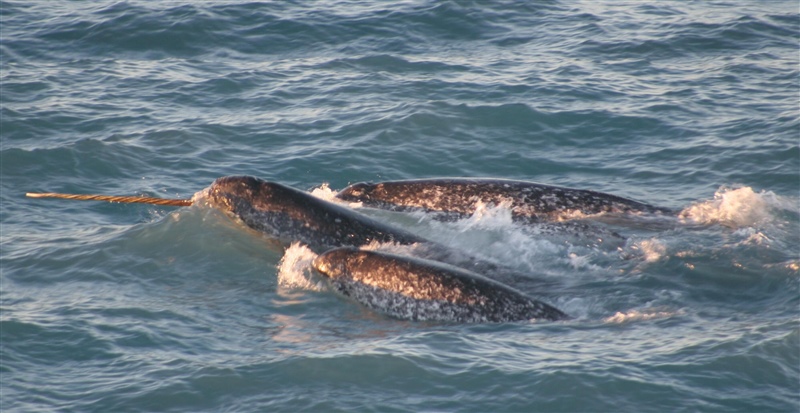
Sea Wonder: Narwhal

Photo Credit: Dr. Kristin Laidre/NOAA/OAR/OER
You wouldn’t be alone if you compared a narwhal (Monodon monoceros) to a unicorn because of the signature spiralized tusk that extends from its head. In fact, it is often called the “unicorn of the sea.” For centuries, they inspired seafaring myths and legends and continue to mystify and fascinate people.
Description
Narwhals are a species of odontocete – toothed whales – that surprisingly don’t have any teeth in their mouths. Instead, male narwhals have the spiralized tusk (an enlarged tooth that grows in a counterclockwise pattern), which can grow as long as 10 feet long; females almost never have the tusk. Their bodies are rounded, and they lack a protruding beak that many other dolphin species have. Their skin is covered in blotchy black and white patterns but they are entirely white underneath, and they have ridges on their backs instead of a true dorsal fin. The pectoral fins on their sides are short and rounded, and their tail flukes generally resemble those of other dolphin species, though males’ flukes have a curled edge, likely to compensate for the weight of and drag created by their tusks. Not including the tusks, males can reach lengths of nearly 15 feet and weigh as much as 3,500 pounds; females are slightly smaller, reaching lengths of about 12 feet and weighing closer to 3,000 pounds.
Diet & Habitat

Photo Credit: Dr. Kristin Laidre
Narwhals live exclusively in Arctic waters near Greenland, Canada, Norway, and Russia. They are most commonly found in offshore areas north of the Arctic circle, but sometimes make their way south, closer to the coasts and fjords of countries like Iceland, in the warmer months. They rely on cold-water species like halibut, squid, shrimp, cod, and species of flatfish. They use echolocation (biological sonar) to help them locate food and feed by vacuuming their prey into their mouths and swallowing it whole. Their diets change seasonally, and they feed more in the winter months, which is the opposite of dolphins that live in warmer waters. No one knows for certain if the tusk helps with hunting, feeding or exerting dominance when confronted with rival suitors. Polar bears, sharks, and orcas are natural predators of narwhals and Inuit tribes have historically hunted them for sustenance and cultural practices.
The narwhal is one of the deepest diving species of marine mammal we know of, capable of diving nearly 6,000 feet below the surface and holding their breath for nearly 30 minutes. They spend most of the winter living under ice sheets, taking advantage of breaks in the ice to breathe.
Life History
Narwhals are difficult to study because they live in remote areas that are hard to reach – the lack of sunlight in the winter months doesn’t help. We do know narwhals spend most of their time in small pods of 10 to 20 individuals, but those pods converge in the summer months where hundreds or even thousands of whales travel together. Males use their tusks for social rituals, including establishing social hierarchies, sometimes sparring with each other for dominance.
Threats & Conservation
Narwhals might be one of the species most vulnerable to climate change due to their reliance on ice and cold-water species to survive. Oil and gas development in the Arctic along with increased shipping activity as ice disappears increase the likelihood of ship strike injuries, interference with echolocation due to industrial noise, and entanglement in lost or discarded gear. Narwhals don’t usually make their way into U.S. waters but are protected by the Marine Mammal Protection Act of 1972 when they do.

Photo Credit: Dr. Mads Peter Heide-Jorgensen/NOAA/OAR/OER
